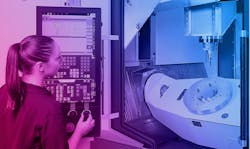Open-Source Standard Accesses More Shop-Floor Data
The OPC Unified Architecture (OPC UA) is a cross-platform, open-source, IEC62541 standard for data exchange from sensors to cloud applications. Its latest version – the OPC UA for Machine Tools Companion Specification – will be demonstrated at IMTS 2022.
The Joint Working Group of the OPC Foundation, supported by the German Machine Tool Builders Assn. (VDW) and German Mechanical Engineering Assn. (VDMA), has produced this supplement to the original standard that makes it possible to access and integrate data from existing inventory systems.
Their OPC UA collaboration is called “umati,” an acronym for the “universal machine technology interface.” The goal of umati is to implement different OPC UA specifications in a uniform manner, thereby allowing the manufacturers of machines, components, and software to offer genuine plug-and-play solutions to their engineering customers and users.
Now, being able to collect operating data and KPIs through umati introduces further advantages in data exchange.
"The update of the specification for machine tools sees us pass a further important milestone.,” commented VDW executive director Dr. Wilfried Schäfer. “This will make the use of the Companion Specifications even more attractive in the future and ensure greater acceptance among industry clients. “Our umati connectivity initiative showcases the open data exchange in a tangible form and naturally plays an important role in this," Schäfer added.
Numerous OPC UA Companion Specifications for machine and plant engineering are currently being developed. These will allow open interface standards based on OPC UA to be used between machines, devices and software, and are being developed into a global production language under the leadership of the VDMA.
Almost 50 such specifications have been published or are currently under development. However, before the exchange of data via existing interfaces or systems can be translated into new, open standards, future-proof technologies such as OPC UA must be broadly established on the market. This applies particularly to shop floor and machine data collection (SFDC and MDC). In most cases, however, customers apply their own in-house standards, which is an obstacle to widespread standardization.
Widespread standardization
The new extension of the OPC UA for Machine Tools Companion Specification addresses this dilemma. The first version concentrated on the global monitoring of machine tool status, whereas the focus of the next step, version 1.01.1, is on collecting important operating data and key performance indicators (KPIs).
The large number of company representatives involved in the process made it possible to incorporate their experience with all the different SFDC/MDC systems used by customers.
Finally, almost all parameters that are currently used in these systems are included in the KPI extension. This makes it possible to use shop floor data in an OPC UA ecosystem through simple mapping or, during a transitional phase, also vice versa. Current initiatives such as the "Catena-X" automotive network are pointing the way toward integrative, platform-based ecosystems that will replace proprietary installations in the medium term.
Dr. Alexander Broos, VDW’s head of Research and Technology, described the project’s the next steps: "We plan to upgrade our umati demonstrator to include “pub/sub” (publish/subscribe) technology in the fourth quarter of 2022. This will simplify the connection of machines and software by a significant degree yet also considerably increase the value of the interfaces for cloud devices."
Other upcoming developments include energy monitoring, job management and machine tending. All three are currently being developed by the OPC UA for Machinery working group in conjunction with the VDMA as part of the harmonization efforts. In addition, an independent working group for additive manufacturing is to be established in the coming months. A new subgroup of the existing machine tool group has also been set up for forming technology.
